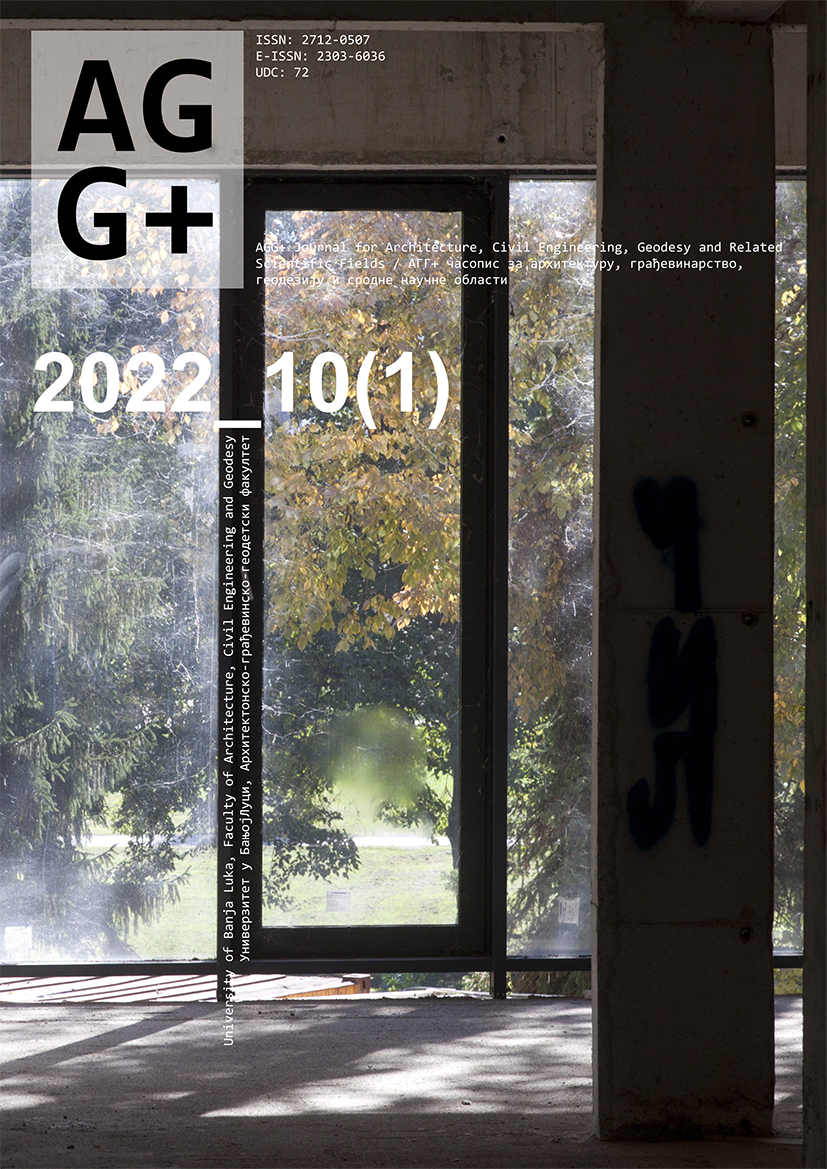Evaluation of the Resistance to Crack Propagation of High-Performance Concretes by the Wedge Splitting Test Method
DOI:
https://doi.org/10.7251/AGGPLUS/2210064SKeywords:
resistance to crack propagation, high-performance concrete, wedge splitting testAbstract
This paper describes the key elements of the results of investigations on the resistance to crack propagation carried out as part of a large-scale project to develop high-performance concretes (HPCs) for the secondary lining of a low and intermediate-level waste disposal shaft. Four HPCs were investigated, in which the quantity of the binder component and the proportions of the two cements and the silica fume in it were varied. We have also added steel fibers to one HPC. The wedgesplitting test method was used to determine the resistance to crack propagation. The results obtained show that all the HPC investigated achieve good resistance to crack propagation. The addition of steel fibers further improves this resistance.
References
H.P. Reinhardt, “Hochleistungsbeton (High Performance Concrete)“, Betonwerk + Fertigteil-Technik, Heft 1/1995 (Concrete Precasting Plant and Technology, Issue 1/1995). pp. 62 – 68, 1995
O.E. Gjørv, “High-Strength Concrete. Advances in Concrete Technology”, CANMET, pp. 21–77, 1992
F. Young, “Very high strength cement-based materials“, Mat. Res. Soc. Vol. 42, 1984. p. 317, 1984
B. Hillemeier, “Innovationen am Baustoffmarkt - Neue Baustoffe sichern das Bauen“, Zement und Beton, Wien. 1/96. pp. 1-8, 1996.
P. Richard, M. Cheyrezy, “Composition of Reactive Powder Concretes”, Cement and Concrete Research, Vol. 25, No. 7. pp. 1501 – 1511, 1995.
M. Cheyrezy, V. Maret, L. Frouin, “Microstructural Analysis of RPC (Reactive Powder Concrete)”, Cement and Concrete Research, Vol. 25, No. 7. pp. 1491 – 1500, 1995.
S. P. Shah. „High Strength Concrete“, University of Illinois at Chicago Circle,
pp. 1-226, 1979.
H. G. Russel, “High Strength Concrete“, ACI SP-87. Detroit, pp. 1 - 278, 1985.
Y. Malier, „ Les bétons à hautes performances“, Presses de l’ENCP, Paris, pp. 1- 543, 1990.
S. Kuroiwa, Y. Mutsuoka, M. Hayakawa, T. Shindoh, “Application of Super-workable Concrete to Construction of a 20-Story Building”, ACI SP-140, pp. 147 – 161, 1993.
P. Stroeven, “Struktura agregata v betonu in njen vpliv na cementno pasto”, Zbornik gradiv in referatov 13. slovenskega kolokvija o betonih: Agregati v betonu. IRMA, Ljubljana, pp. 9 – 20, 2006.
A. Zajc, „Uporaba mineralnih dodatkov v cementu in/ali betonu“, IRMA. pp. 1-90, 2014.
S. Mindess, J.F. Young, D. Darwin, „Concrete“, Prentice Hall Inc Englewood Cliffs, pp.80-543, 2003.
S. Diamond, S. Mindess, J. Lovell, “On the Spacing between Agreggate Grains in Concrete and the Dimension of the Aureaole of Transition”, RILEM Colloquium, Toulouse, pp. C42 – C46, 1982.
V. Rudert, J. Strunge, H.D. Wihler, „Beton aus anderer Sicht – filigranes Mikrogefüge“, Betonwerk + Fertigteil-Technik 60. No. 9. pp. 86 – 93, 1994.
J. Šušteršič, „Doseganje posebnih lastnosti betona z dodatki“, Zbornik gradiv in referatov 14. slovenskega kolokvija o betonih: Posebne lastnosti betonov z dodatki, IRMA, Ljubljana, pp. 9 – 19. 2007
E.K. Tschegg, „Prüfeinrichtung zur Ermittlung von bruchmechanischen Kenwerten sowie hiefür geeignete Prüfkörper“, 1986.
H. Linsbauer, E.K. Tschegg, „Die Bestimmung der Bruchenegie an Würfelproben“. Zement und Beton. 31 (1986) 1, pp. 38 – 40, 1986.
E.K. Tschegg, “Patent application No. 48/1990. Lasteinleitungsvorrichtung“, 1990.
E.K. Tschegg, “New Equipments for Fracture Tests on Concrete”, Materialprüfung 33. 11 – 12. München, pp. 338 – 342, 1991.
J. Šušteršič, R. Ercegovič, D. Polanec, A. Zajc,“Evaluation of behavior of the joint between two concrete layers during splitting”, V: SERNA, Pedro (ed.). Fibre reinforced concrete : improvements and innovations II : X RILEM-fib International Symposium on Fibre Reinforced Concrete (BEFIB) 2021. Cham: Springer, cop. 2022. RILEM bookseries, vol. 36. pp. 208-219., 2022.
L. Chen, S. Mindess,, D.R. Morgan, „Toughness Evaluation of Steel Fibre reinforced Concrete“, Proceedings of 3rd Canadian Symposium on Cement and Concrete, Ottawa, pp. 16 – 29, 1993.
D.R. Morgan, S. Mindess, L. Chen., „Testing and Specifying Toughness for Fibre Reinforced Concrete and Shotcrete“, Fibre Reinforced Concrete- Modern Developments. Eds.: N. Banthia and S. Mindess. The University of British Columbia, Vancouver, pp. 29 – 50, 1995.
J. Šušteršič, A. Zajc, I. Leskovar, V. Dobnikar, “Improvement in the crack opening resistance of FRC with low content of short fibres”, Ed.: Dhir, Ravindra K. Role of concrete in sustainable development: Proceedings of the International Symposium dedicated to professor Surendra Shah, Northwestern University, USA held on 3-4 September 2003 at the University of Dundee, Scotland, UK. London: ˝Thomas Telford. pp. 167-174, 2003.
J. Šušteršič, R. Ercegovič, „Poročilo projekta Študija proizvodnje, vgradljivosti in karakteristik končnih betonskih mešanic za izvedbo sekundarne armiranobetonske obloge silosa odlagališča NSRAO“, IRMA, Ljubljana, pp. 1-646, 2020.
B. Grujic, “Mikroarmirani beton – primjena u geotehnici”, Arhitektonsko-građevinsko-geodetski fakultet Univerzitet u Banjoj Luci, Banjaluka, 2022.
O. Osamah, G. Emad, P. Tilak, L. Jessey, A. Kamiran, “Evaluation of Concrete Material PropertiesatEarly Age”, CivilEng 2022, 3(4), pp. 909-945, 2022.

